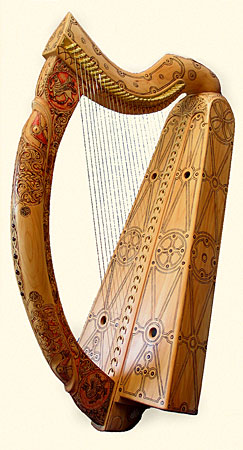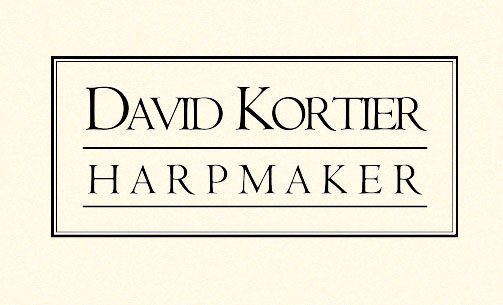|
The clarsach, or small harp, strung with metal strings has
been the national symbol of Ireland for centuries. These harps
have been objects of great significance, and the harpers were
often granted special status. The playing of these instruments
declined in the 19th century, but has enjoyed a revival in recent
years.
The technique of playing these harps was usually with the
fingernails. In this way a beautiful sound is produced, one of
profound beauty, bell-like and lyric, with a haunting sustain.
The soundbox was typically hollowed from a single block of wood,
usually willow, and the other parts were often elaborately carved
and decorated. There are fewer than 20
early Irish harps surviving, that we know of, mostly residing
in museums, many in Ireland. Of these harps, only a handful are
regularly copied or used as models for building new instruments.
I have examined many of these harps, taken measurements and photos,
and offer replicas that are as accurate as I can possibly make
them.
The reason for wanting a replica of
a museum harp is primarily related to historically informed performance
practice. (This is another way of saying that this instrument,
as it was built then, is the most appropriate instrument for
playing the music of that time, often revealing aspects that
would not be apparent when played on a modern instrument with
modern techniques.) Or, you could simply decide that these harps
are beautiful and significant instruments which could enhance
your life tremendously.
At this point, I am producing the following
models. The names are those commonly associated with each model,
usually assigned by the most prominent owner, or where the harp
was located for the majority of its life. For a discussion of
each original, look at Simon Chadwick's informative webpage:
http://www.earlygaelicharp.info/harps/
Replicas of historical harps are undertaken
by arrangement. Delivery time is 6 months to a year or more from
date of order. Because of this investment of time, I ask for
a 20% deposit, nonrefundable, with the order, and the balance
is due upon completion.
Queen Mary Harp $15,000
Trinity College Harp $15,000
Lamont Harp $16,000
Downhill Harp $18,500
Castle Otway Harp $17,500
Mullagh Mast Harp $17,500
Sirr Harp $18,500
Kildare Harp $18,500
O'ffogarty Harp $20,000
Bunworth Harp $22,500
Cloyne (Dalway) reconstruction $35,500
Scale Drawings of Early
Irish harps
In response to requests for measurements of the early Irish
harps that I have studied, I have printed up full sized sheets
in 1:1 scale. These are not plans for building a harp, nor are
they detailed museum quality drawings. Instead, I have simply
traced the outlines of my shop templates. They are printed actual
size, with an inch scale to verify the accuracy. Since I have
taken great care with my templates to faithfully reproduce the
significant dimensions of the original harps, including string
lengths and spacings, all information needed to produce an accurate
replica can be taken directly from these tracings. In some instances
elements have been simplified, and none of the decorative features
are shown. Additionally, the joinery is not shown, as these details
generally cannot be seen in the museum originals. In other words,
you must be an experienced and resourceful woodworker to build
a harp using these drawings. But as a resource to verify size,
shape, and functioning of these harps, the information on these
sheets is very useful, and can be relied upon.

Each harp is drawn on a single sheet of heavy paper and delivered
folded in a large envelope. The price is $65 each, postpaid.
The models currently available are:
The Queen Mary Harp, Museum
of Scotland, Edinburgh
The Trinity College Harp, Trinity
College Library, Dublin (the so-called Brian Boro harp)
The Downhill Harp, Guinness
Brewery Company, Dublin
The Castle Otway Harp, Trinity
College Library, Dublin
The Lamont Harp, Museum of Scotland,
Edinburgh
Photo story- Replicating
the Bunworth harp
Photo story- Building
the Student Trinity harps
Photo story- Trinity College
replicas for Ann Heymann and Siobhan Armstrong
Report- Scotland, June
2000
Report- Ireland, January
2002
Z toggles- an alternative
string anchor
|
 O'ffogarty replica
O'ffogarty replica
 Queen Mary replica
Queen Mary replica
 Downhill replica
Downhill replica
 Bunworth replica
Bunworth replica |

